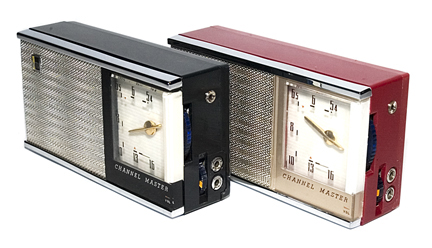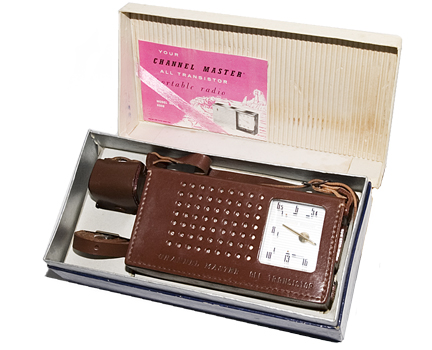Vintage Channel Master Transistor Radios by Sanyo
Channel Master Model 6506

 These radios were made for Channel Master in Japan by Sanyo in 1959-60. They are six transistor radios. The sound quality is very good, and the radios pull in stations very well. The radios are very well made, solid as a brick, and are considered by some to be among the most stylish transistor radios of the era. This model uses four AA cells in a 2x2 holder. The black radio performed very well as found. The red radio had good volume and sound, but was only picking up about half the stations that the black radio could. The red radio came with its original box, owners guide, case, strap, and external antenna and earplug in a small case. I removed the chassis from both radios and checked all connections, shot a little contact cleaner in the volume pot, and cleaned and polished the cases. The internal ferrite rod antenna in the red radio was loose as both mounts were broken. I repaired those. The red radio was also missing the holder for the AA cells, so I bought a replacement at Radio Shack. I also replaced the battery snap terminal which had some corrosion which couldn't be removed without further damaging connector. I then recapped the chassis from the red radio, which brought its performance up to par.
These radios were made for Channel Master in Japan by Sanyo in 1959-60. They are six transistor radios. The sound quality is very good, and the radios pull in stations very well. The radios are very well made, solid as a brick, and are considered by some to be among the most stylish transistor radios of the era. This model uses four AA cells in a 2x2 holder. The black radio performed very well as found. The red radio had good volume and sound, but was only picking up about half the stations that the black radio could. The red radio came with its original box, owners guide, case, strap, and external antenna and earplug in a small case. I removed the chassis from both radios and checked all connections, shot a little contact cleaner in the volume pot, and cleaned and polished the cases. The internal ferrite rod antenna in the red radio was loose as both mounts were broken. I repaired those. The red radio was also missing the holder for the AA cells, so I bought a replacement at Radio Shack. I also replaced the battery snap terminal which had some corrosion which couldn't be removed without further damaging connector. I then recapped the chassis from the red radio, which brought its performance up to par.
Channel Master Model 6515

This 1960 radio is often called the 6506's "big brother." A solid, handsome, well-built radio, the 6515 "Super Fringe" is an eight transistor radio capable of pulling in distant stations. Like the smaller 6506, this model has good sound quality and sensitivity. Powered by four C batteries, the radio is much heavier than its little brother, and about 1/3 again larger. It features an external antenna connection, ear phone plug, and external speaker plug. Shortly after I acquired the radio, I noticed that I could hear a pop or crackle from it every now and then when the radio was supposed to be off. I hooked up a milliammeter and found it was drawing a few mA of current even when shut off. I pulled the chassis and the first thing I found was that the positive battery terminal wire had come un-soldered at the on/off switch on the volume control, and was probably intermittently shorting against the chassis. I resoldered it and tested it with the milliammeter and there no more current draw when the switch was off. I also noticed that four of the eight capacitors had been replaced.




 These radios were made for Channel Master in Japan by Sanyo in 1959-60. They are six transistor radios. The sound quality is very good, and the radios pull in stations very well. The radios are very well made, solid as a brick, and are considered by some to be among the most stylish transistor radios of the era. This model uses four AA cells in a 2x2 holder. The black radio performed very well as found. The red radio had good volume and sound, but was only picking up about half the stations that the black radio could. The red radio came with its original box, owners guide, case, strap, and external antenna and earplug in a small case. I removed the chassis from both radios and checked all connections, shot a little contact cleaner in the volume pot, and cleaned and polished the cases. The internal ferrite rod antenna in the red radio was loose as both mounts were broken. I repaired those. The red radio was also missing the holder for the AA cells, so I bought a replacement at Radio Shack. I also replaced the battery snap terminal which had some corrosion which couldn't be removed without further damaging connector. I then recapped the chassis from the red radio, which brought its performance up to par.
These radios were made for Channel Master in Japan by Sanyo in 1959-60. They are six transistor radios. The sound quality is very good, and the radios pull in stations very well. The radios are very well made, solid as a brick, and are considered by some to be among the most stylish transistor radios of the era. This model uses four AA cells in a 2x2 holder. The black radio performed very well as found. The red radio had good volume and sound, but was only picking up about half the stations that the black radio could. The red radio came with its original box, owners guide, case, strap, and external antenna and earplug in a small case. I removed the chassis from both radios and checked all connections, shot a little contact cleaner in the volume pot, and cleaned and polished the cases. The internal ferrite rod antenna in the red radio was loose as both mounts were broken. I repaired those. The red radio was also missing the holder for the AA cells, so I bought a replacement at Radio Shack. I also replaced the battery snap terminal which had some corrosion which couldn't be removed without further damaging connector. I then recapped the chassis from the red radio, which brought its performance up to par.